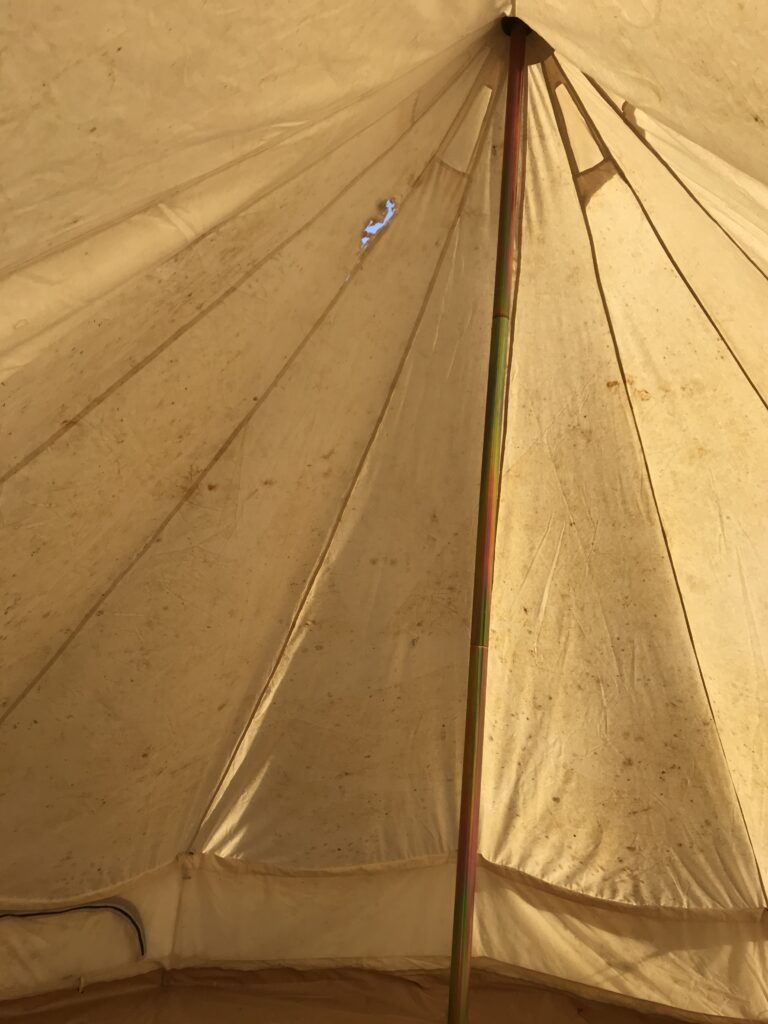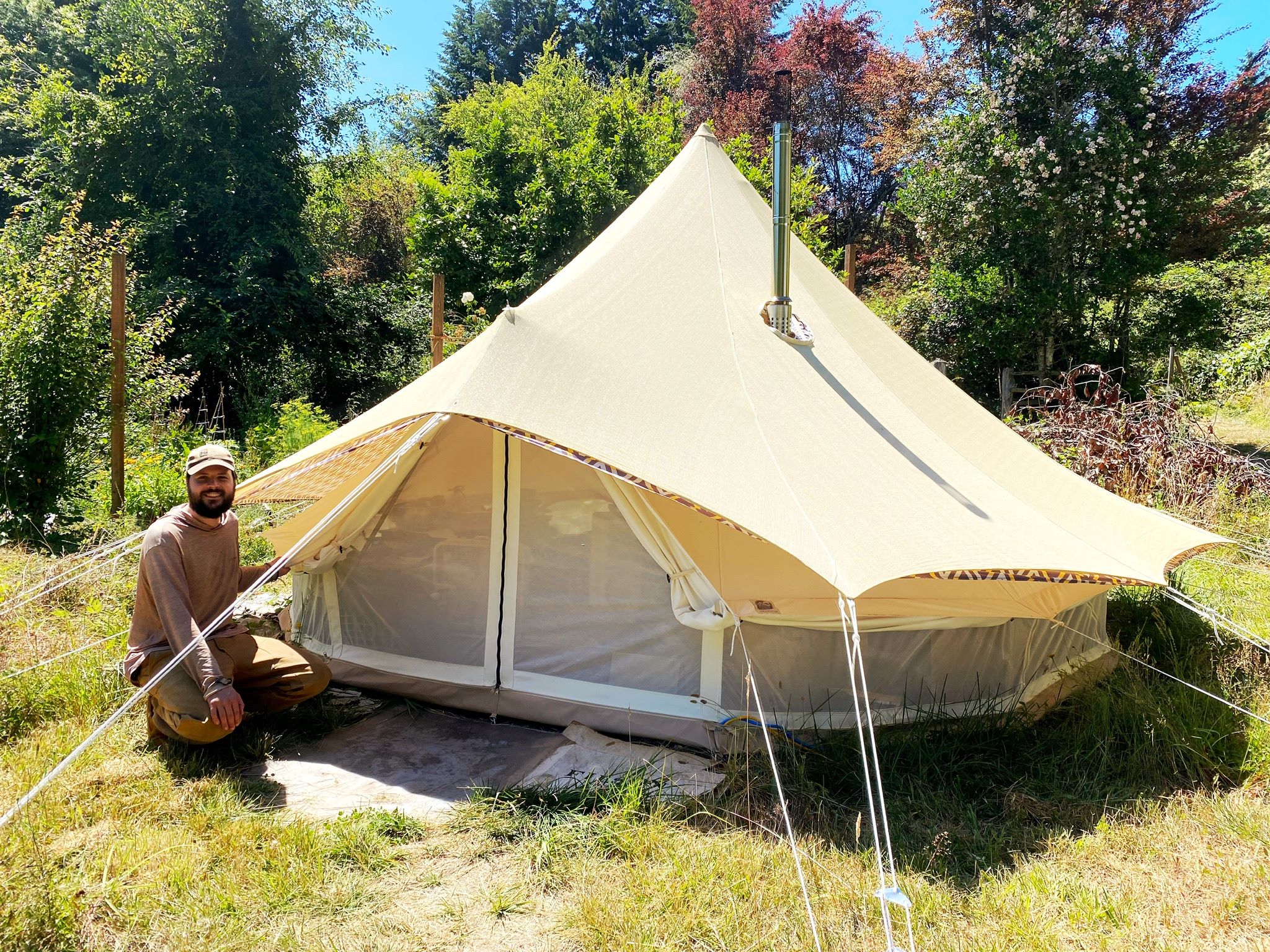Stout Tent canvas is treated to be both waterproof and mold resistant.
Still, your tent needs your help to stay mold and mildew free. In the following pages, you’ll find easy and practical tips to follow. If you do not have a Stout Tent, you can tell if your tent has been treated by the way the canvas reacts to water.
Water should bead up and run right off your tent, not soak into the material; there should be no noticeable change in the color of the fabric. Your new canvas tent should not need to be “seasoned” as other companies may tell you.
Stout Tent canvas is also treated for mold prevention. Mold precention treatment is the most expensive part of canvas tent treatment and, in our opinion, the easiest to neglect.If the canvas isn’t waterproofed, it’s quick and easy to spot. If it isn’t mold-proofed, it can be difficult to test.
The only way to really confirm mold proofing is to get a lab certificate from a 3rd party independent lab. This is what we do! We ask an independent lab to analyze our canvas for the top 500 mold strains found in North America. Technically, it is still possible you could have mold growth from a one-off strain, but highly unlikely.
Now on to tips for preventing mold from forming in the first place.
TIP 1: Mind the water and snow run off.
When water is not allowed to pool it makes it harder for mold to form. The steps below will keep your tent from having water inside from run-off at the eaves, groundsheet zipper, or windows.
- Make sure water is not pooling on any of the eaves. Make sure line tension is appropriate.If you’re using a platform, be careful not to over tension. The platform offers less flexibility than the earth and this can cause stress on the cone.
- Make sure the roof is extended over sidewalls.
- Ensure water is not dripping off of roof line onto canvas sidewalls. Keep the canvas flap down and over the groundsheet zipper.
- Make sure the a-frame is upright and eave is protecting the door.
- When closing the door make sure the door flaps are covering the zipper so water cannot get in.
- During inclement weather, keep windows and canvas shutters zipped. (We recommend leaving the zippers parted at the top to allow ventilation – unless you see rain coming in!)
TIP 2: Prevent Condensation.
Pick the right tent!
Cheaper bell tents use materials that are coated with a synthetic lining and are designed to mimic natural canvas. These tents are prone to condensation issues. If you see a substantial amount of water droplets forming on the inside of the tent, contact your retailer.
Site selection
Choose loamy forest duff or nicely draining soil, or gravel. Avoid wet grass. Don’t set up on saturated ground. If it’s wet or spongy, skip it.For more information, check out this quick YouTube video.
Don’t cook inside your tent
This one is a bit tricky because while water vapor from boiling food and water adds water to the air, a wood-burning stove will dry and remove it. We’re big fans of having a tent stove for warmth and ambiance, just move it outside if you want to cook with it.
Be prepared for rain
Rain makes condensation worse. If you don’t have a good, breathable canvas tent, you’ll want to carry a towel to wipe down the inside of your tent.You may also want a towel for your Stout Tent the first time you camp in the rain. Sometimes the areas around the stitching need to season. If this happens, you’ll notice small droplets your first time out.
Heat!
Add a wood-burning stove! As mentioned above, our stove will dry out the air and warm things up for you. We’re also big fans of propane heaters, but be warned that those off-gasses a water vapor which increases condensation inside of a tent that’s not well ventilated.
Ventilation and dryness
Moisture will build in a sealed tent, and cause problems until removed. Below are some tips on using ventilation to fight moisture and condensation from the inside.
- If your Stout Tent has the Double-Wall feature, be sure to raise the sidewalls during the day (and in good weather!).
- Check that your windows are properly vented – all the way open when it’s not raining, cracked at the top when it is. Doors should be open and vented when possible as well.
- If you’re located somewhere super muggy and humid, add a fan, or even an AC Unit. (We do not recommend adding the AC jack for your exhaust by yourself!). Check that the canvas dries 100% each day.
- During a wet period, even if it’s not cold, consider heating the inside of the tent to help the canvas dry.
- Place the tent in the sun where it is more likely to dry.
- Consider adding a layer of protection from above. Our sunshade can keep moisture in the air from condensing on the outside of the tent canvas, keeping everything dryer.
TIP 3: Spot treat mold spots before it spreads.
Our canvas is treated against the 500 most popular strains of mold in North America. In most areas mold and mildew won’t be an issue unless you are dealing with a particularly difficult strain that isn’t protected against in our factory treatment.

Spot Cleaning
If you see mold start to grow, even a bit of discoloration, you will want to spot treat the affected area. One option we like is Liquid Mold Remover, helpful for prevention and spot cleaning. You can also always use dish soap and water.
For wiping down condensation and moisture inside of the tent, spray a washrag with the Liquid Mold Remover and place it over a broom. You’ll be able to use the broom to reach the high ceilings and walls of your tent.
Another way to spot clean any discoloration or mildew you find is warm water, Ivory soap, and a soft-bristle brush. Some customers have used a swimming pool brush with a shorter extension for this.
Use the Sun
Ideally, your tent will get some sun each day to keep things nice and dry. While a complete tree cover provides a shady break from the heat, moisture tends to be higher in these areas. More moisture means more mold. If you are considering a fully-shaded setup, consider adding an anti-fungal treatment to your maintenance routine.
Some of our more eco-conscious properties use diluted lemon juice/ peroxide to spot treat areas. The sun does a fantastic job of drying and bleaching the canvas.
When cleaning, set up your tent in an area where the sun is able to shine directly on any spots or stains you have found – a good dose of UV rays will help considerably in clearing up the canvas.
Bird Droppings
Birds droppings can be acidic and dangerous for the canvas, and they can also carry mold spores. These spots should be cleaned quickly to prevent staining, and damage to the canvas. Fortunately, bird droppings are usually pretty easy to clean, though sometimes they can stain. Try small spots with one of these methods:
Use a baking soda and dawn dish soap mixture and clean the spot with a toothbrush or similar soft bristle brush.
Use a power washer to clean the canvas. Set the wash to under 70psi to avoid damaging or puncturing the canvas!
Sap
Sap is a tough clean. You’ll want to get to this as soon as you notice it. As you see, the methods are the same as above:Use a baking soda and dawn dish soap mixture and clean the spot with a toothbrush or similar soft bristle brush.Use a power washer to clean the canvas. Set the wash to under 70psi to avoid damaging or puncturing the canvas! After cleaning you may need to reapply the waterproofing. You’ll find directions on how to do that in The Stout Tent Maintenance Guide.
You can check to see if your tent is made of real canvas by holding it to your mouth and blowing through it. If you can’t blow through the material, it is NOT made from real canvas. So that you can test the quality of Stout Tent canvas tents for yourself, we offer canvas swatches and samples.
Setting up under trees is popular because of the shade and the beauty, but it can be hazardous for your canvas. Consider a Sunshade like the one pictured to cut temperature and keep falling foliage and bird droppings off your tent.

Tip 4: Never put your tent away wet!
That is the fastest way to create a mold problem! Be sure your tent is BONE DRY when you pack it up!
We recommed taking a dry towel and tracing it along all of the tent creases inside and out to soak up any hidden moisure before taking down your tent to store.
For more information, we’re just a phone call or email away!
602.845.0609
info@stouttent.com


